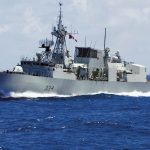The Kirov class is a set of four warships belonging to the Russian Navy. Officially designated heavy nuclear powered missile cruisers (roughly “Raketny Kreyser” in Anglicized Russian) they are often considered battle cruisers due to their sheer size and power relative to the cruisers of other navies, the Kirovs caused a great deal of alarm in western naval circles when they began to come online in the late 1970’s. Long laid up due to lack of funds and the damage caused by a reactor accident in the class leader, the Kirov, the resurgent Russian economy is allowing the Russian navy to salvage and revamp the entire class, now known under new names, and bring all four members into service by 2020.
To understand the implications of the effort to salvage Admiral Nakhimov (formerly the Kalinin) and the other members of the Kirov class cruisers, the original design intent and the geopolitical situation that birthed them is worth examining.
Kirov Class Design: Origins of the Effort to Salvage Admiral Nakhimov
In the 1970’s, Admiral Gorshkov- at the time often called the father of the modern Soviet Navy- presided over a major realignment of Soviet naval strategy. Previously the Soviet Navy concentrated its efforts on securing Soviet and Warsaw Pact coasts from amphibious assault as well as submarine-based nuclear deterrent from western attack subs. Recognizing the growing danger of nuclear-armed carrier battle groups penetrating to the Barents Sea, the Soviet Navy constructed a balanced surface fleet capable of meeting western attacks head on.
The Kirovs were at the center of surface action groups intended to saturate and overwhelm the defenses of NATO carrier battle groups with cruise missiles fired from ships, aircraft, and submarines. Although formidable, US carrier battle groups attacked from multiple directions could be overwhelmed; even if the carriers themselves were not sunk, damage done to their flight decks would force them to retreat.
The ships were armed to the teeth with anti-air and anti-submarine weapons to give them the best possible chance of surviving long enough to smash an opposing carrier group. In addition they were and are equipped with an unusual form of propulsion- a combined nuclear and gas power plant that ensures redundancy in the event of battle damage. As the Kirovs are brought back into service, this unique propulsion system continues to be unique among the navies of the world.

Prior to Salvage: Admiral Nakhimov Specifications

Four Kirovs were built, and their original names were Kirov, Kalinin, Frunze, and Yuri Andropov. Since the collapse of the Soviet Union, each ship has received a new name- Admiral Ushakov, Admiral Nakhimov, Admiral Lazarev, and Pyotr Velikiy- respectively.
Each ship is slightly different from its brethren, a function of experimentation, optimization, and technological advancements between the deployment of Kirov in 1980 and the work to salvage Admiral Nakhimov in the mid 2000s.
One immediate geopolitical effect of the Kirov class was the revamping and reconstruction of the World War II-era US Iowa Class battleships which were intended to form surface action groups of their own and face down the new threat.
Kirov class approximate characteristics (each class member was outfitted slightly differently):
· 24,000 tons standard displacement
· 820 ft long, 93 ft beam, 33 ft draught, 700-900 crew
· Two nuclear reactors plus gas boilers producing 120 mW total power
· Approximate top speed of 35 knots utilizing nuclear and gas power
· Virtually Unlimited range on nuclear power at ~20 knots, about 1000 nautical mile range when fully utilizing gas boilers to reach top speed
· Main armament 20 SSN-19 “Shipwreck” cruise missiles in vertical launch system (VLS) located forward of the superstructure
· Long range air defense system in VLS: 96 SAN-6 Grumble/SAN-20 Gargoyle surface to air missiles – naval variant of S-300 system
· Layered close range air defenses of 44 SAN-4 Gecko short range, 192 SAN-9 point defense, and 6 CADS-N-1 point defense systems
· 2 100 mm or 130 mm guns, ten torpedo tubes capable of firing torpedoes, and SSN-15 anti-submarine missiles, anti-submarine rocket mortars, hangar for up to three helicopters
Multiple search, navigation, and guidance radars; hull mounted and towed array sonar systems
To salvage Admiral Nakhimov will not be enough to make the reborn Kirov class useful warships. The technology that went into the ships is now thirty years old at best, and advances in precision weaponry and stealth technology will necessitate new weapons, sensors, and defenses. The fourth ship in the Kirov class, the Pyotr Velikiy, is the flagship of the Northern Fleet and has the most modern equipment. The other vessels will be more difficult to Salvage. Admiral Nakhimov is likely to set the stage for revamping the other vessels, and though the details of its upgrade are not yet confirmed, there are a few aspects of the class that are likely to receive significant attention. Kirov class battle cruisers will likely sail the high seas once again within a decade, allowing Russia to project naval power into any oceanic region.
Russia’s economic future has brightened with the rise in oil prices of the past decade. And as its economy has stabilized, Russia has sought to reclaim military standing in the broader world.
The Impetus Behind the Decision to Salvage Admiral Nakhimov

In light of this, the decision to revamp Admiral Nakhimov is easy to understand. The design and construction of an entirely new class of warships is unnecessary when three mothballed warships considered to be powerful vessels are lying dormant in your national naval yards. As evidenced by the age of some active United States naval vessels – 50 years in the case of the USS Enterprise – the twenty to thirty year old hulls of the Kirovs have plenty of life left in them.
Whatever the cost/benefit analysis done, the Russian government has decided to reconstruct the Admiral Nakhimov and the other two members of the renamed Kirov class cruisers- Admiral Ushakov and Admiral Lazarev- and join them with the Pyotr Velikiy as the nexus of a renewed Russian navy.
After the Salvage: Admiral Nakhimov Air Defense Updates
The updates made to Pyotr Velikiy since the vessel’s commissioning in the mid 1990’s give a hint at the likely upgrades intended once initial work to salvage Admiral Nakhimov is completed. Pyotr Velikiy has been armed with an upgraded version of the S-300 long range surface to air missile system, which has received the designation SAN-20 Gargoyle by NATO, and it is likely that all of the updated Kirov cruisers will as well. It is conceivable that the follow on to the S-300 system, the S-400, could be naval-ized and included as part of an upgrade of the vessel’s anti-aircraft armament.
Mid-range surface to air defense upgrades would likely be added to the Kirov at the least – the later vessels all replaced the Kirov’s original SSN-14 anti-submarine missile launcher with the SAN-4 mid-range system.
As far as point defenses go, the vessels will likely all be brought up to the CADS-N-1 standard: it is a powerful point defense system that incorporates a Gatling cannon with several point defense missiles. A naval variant of the armament of the 2S6 Tunguska, this system provides the Pyotr Velikiy and, after salvage, Admiral Nakhimov and the others with no fewer than four layers of air defenses capable of engaging threats ranging from aircraft to cruise missiles and even smart bombs.
Question for the Revamped Kirovs: Upgrade the Main Armament?
Probably the most salient characteristic of the Kirov class cruisers is their main battery of twenty large, powerful cruise missiles. The SSN-19 Shipwreck weighs around 7000 kilograms and can fly around 600 kilometers. A formidable weapon, the SSN-19 can be fired in a swarm where most of the missiles will remain close to wave level but be guided and targeted independently based on programmed parameters by one control missile that maintains radar contact with the target.

But the missile is large, and as the Russian navy proceeds to update the vessels, the question has to be asked: will the main armament of the ships be altered? The SSN-19 is now a dated design and has become the basis for later missiles including the Brahmos. In an age of ever greater destructive power in smaller, more precise packages, might the Kirov’s receive an update to arm them with larger numbers of smaller cruise missiles?
Parting Thoughts on the Kirov Class Cruisers

A unique vessel, the revamped Kirov class will see the return of a second member after the Russians complete work on Admiral Nakhimov and return the ship to active service sometime around 2013. Eventually joined by the other two members of the class, they will allow the Russian navy to send a formidable force to any ocean they choose.



Comments are closed